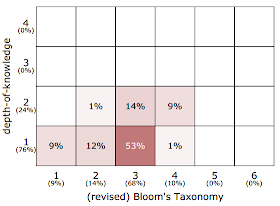 by John R. Walkup, Ph.D.
by John R. Walkup, Ph.D.Long a mainstay in education, matrices are increasingly popping up all over to help teachers map everything from standards to assessments, standards to grade levels, and so on.
Time to create one more matrix. But first, let's discuss two matrices directly related to lesson rigor.
Cognitive Rigor Matrix
We have discussed the Cognitive Rigor Matrix thoroughly throughout this blog. In short, the Cognitive Rigor Matrix superposes the Depth of Knowledge and the Cognitive Process Dimension of Bloom's Revised Taxonomy and has been heavily used in our statewide curriculum studies.An example from our Oklahoma study is shown below. From the darkest cell in this chart, we can see that 53% of the work samples we collected from sixth-grade classrooms in Oklahoma aligned to the apply-level of Bloom's Taxonomy (Level-3) and the lowest Depth of Knowledge level (i.e., DOK-1). (We call this type of student work "plug-and-chug"; see here for more discussion on plug-and-chug mathematics and its impact on mathematics instruction.)
For more discussion about the Cognitive Rigor Matrix, see the article we coauthored with Karin Hess titled "Cognitive Rigor: Blending the Strengths of Bloom's Taxonomy and Webb's
Depth of Knowledge to Enhance Classroom-level Processes."
Heer Matrix
Rex Heer of the Center for Teaching and Learning at Iowa State University created the following matrix that connects the Knowledge and Cognitive Process Domains of Bloom's Revised Taxonomy. He reasoned that learning objectives sample particular areas of the Knowledge Domain (i.e., what the student will learn) and the Cognitive Process Dimension (i.e., the type of thinking skill does the learning objective entail).Looking at the circled example in the chart, a learning objective that states "We will classify adhesives by toxicity" will correlate to the type of thinking associated with the understand-level of the Cognitive Process Dimension and target conceptual development described in the Knowledge Dimension. (If the classification process involved examining each of the critical features of each adhesive, then the activity could align to the analyze- or even evaluate-level of the Cognitive Process Dimension.
For more information about the Heer Matrix, see the article "A Model of Learning Objectives" posted by the Iowa State University Center for Excellence in Learning and Teaching and Patti Shank's blog post "Reconsidering Bloom's Taxonomy (Old AND New)."
A new matrix
To complete the synthesis among Depth of Knowledge and the two dimensions of Bloom's Revised Taxonomy, we would find it only natural to formulate a matrix that correlates Depth of Knowledge with the Knowledge Dimension, as seen below..jpg) Seeking training at your school or district centered on Cognitive Rigor or Depth of Knowledge? Call me at (559) 903-4014 or email me at jwalkup@standardsco.com.
Seeking training at your school or district centered on Cognitive Rigor or Depth of Knowledge? Call me at (559) 903-4014 or email me at jwalkup@standardsco.com. We will discuss ways in which I can help your teachers boost student engagement and deep thinking in their classrooms. I offer workshops, follow-up classroom observation/coaching, and curriculum analysis to anywhere in the country (and even internationally).
Follow me on Twitter at




No comments:
Post a Comment